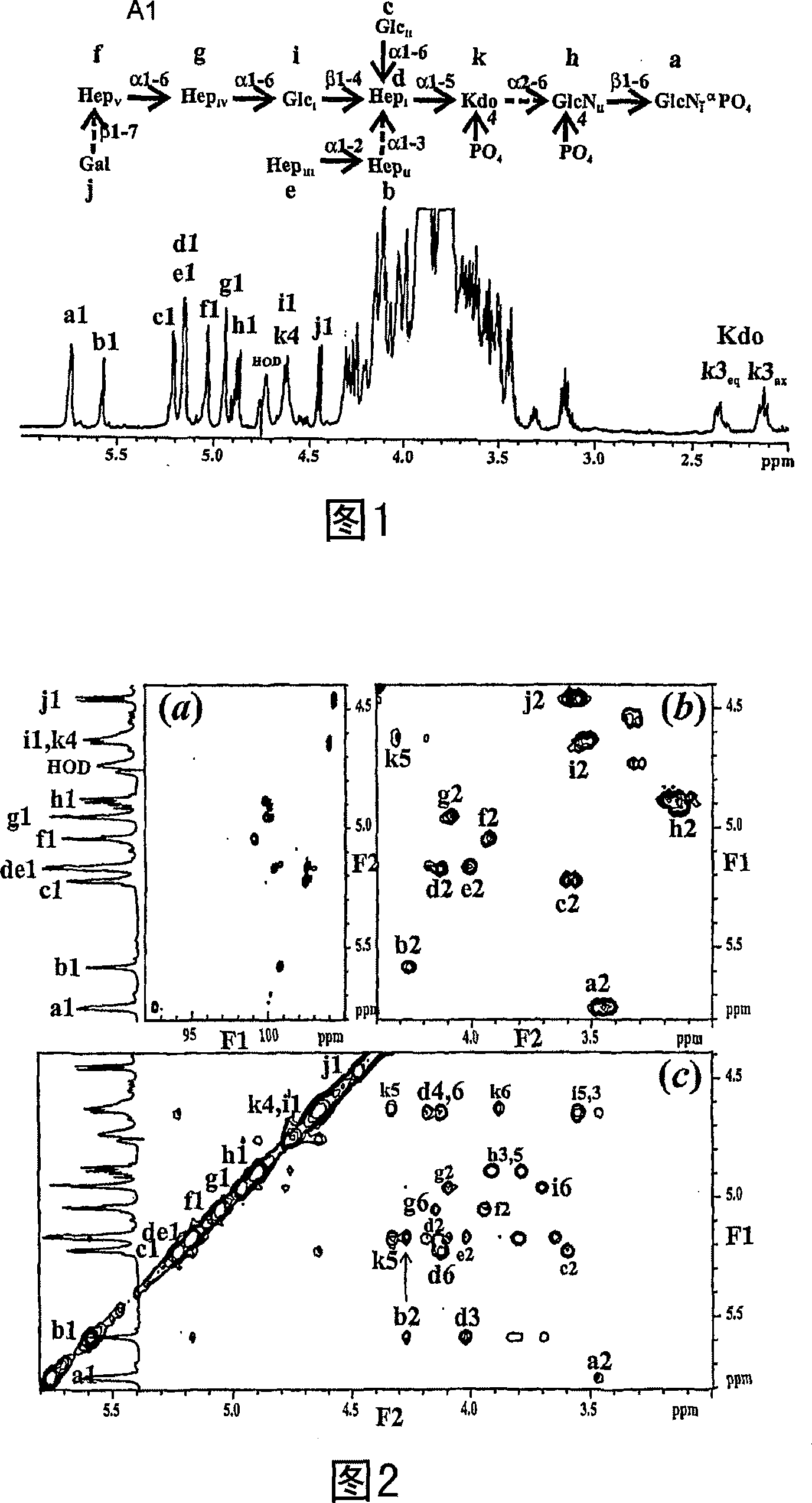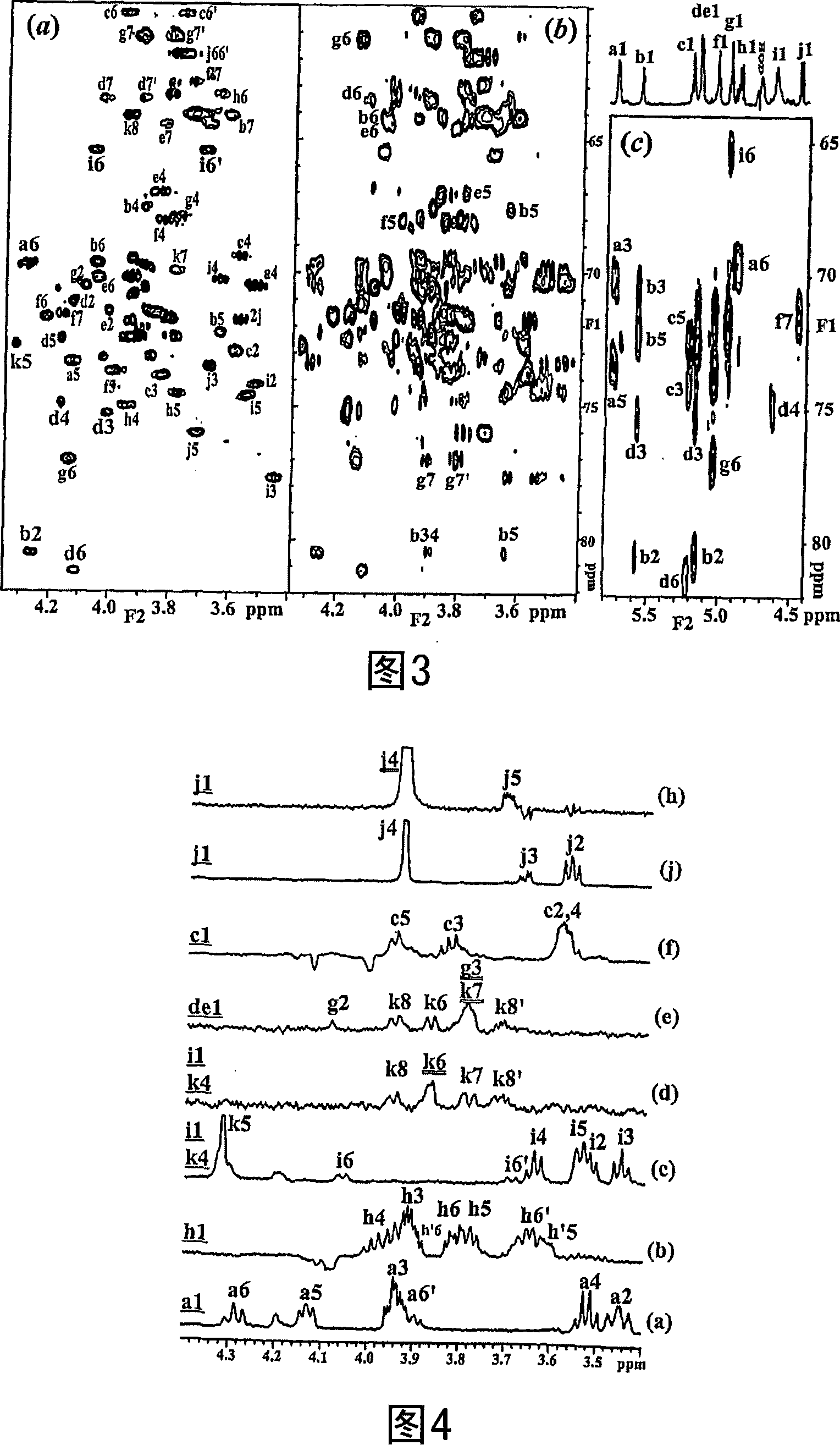Conserved inner core lipopolysaccharide epitopes as multi-species vaccine candidates
A lipopolysaccharide and conservative technology, applied in the direction of multivalent vaccines, vaccines, sugar derivatives, etc., can solve the problems that a single component cannot provide protection and has no bactericidal effect
- Summary
- Abstract
- Description
- Claims
- Application Information
AI Technical Summary
Problems solved by technology
Method used
Image
Examples
Embodiment 1
[0174] This example forms the basis for the publication in Can. J. Chem. 80, 1715 (2002). Study Mandellium haemolyticus serotype A1. Analysis of the LPS of M. haemolytica serotype A1 showed that Hex 3 Hep 5 Kdo is the main core oligosaccharide component. This was determined by mild acid hydrolysis (1% HOAc, 100° C., 3 h) of LPS samples and 1D 1H NMR and FAB-MS analysis of the obtained oligosaccharide fractions. GLC-MS analysis of sugar alcohol acetate and 2-butyl glycoside derivatives of core oligosaccharides showed that the main components of core oligosaccharides contained D-glucose, D-galactose, L-D-heptose and DD- Heptose, its molar ratio is 2:1:3:2. The D-Gal residue was found to be the terminal non-reducing part from the methylation analysis, and in the presence of Hex 2 Hep 5 Kdo is missing in a minority of components of the core oligosaccharide component. The presence of Kdo in LPS was confirmed by colorimetric analysis.
[0175] The LPS of M. hemolyticus is fi...
Embodiment 2
[0229] This example forms Carbohydr.Res. 339 : Basis for publications in 1973 (2004). Actinobacillus pleuropneumoniae serotypes 5a, b, 2 and 1 were studied.
[0230] Sugar analysis of column-fractionated LPS showed glucose (Glc), galactose (Gal), N-acetyl-glucosamine (GlcNAc), D-glycerol-D-mannose-heptose (DD-Hep) and L- The respective ratios of glycerol-D-mannose-heptose (LD-Hep) are approximately 2:1.5:1:2:3. Core OS was purified by gel filtration chromatography of the acid hydrolyzate as described in Materials and methods to obtain a fraction enriched in core OS and relatively free of O-antigen, and subjected to sugar analysis, which revealed; Glc , Gal, DD-Hep, and LD-Hep in a ratio of 2:1:2:3. Since the capsular polysaccharides of serotype 5b contain N-acetyl-D-glucosamine and ketose residues, we suspected some capsular (CPS) adulteration of LPS, the absence of CPS in the fractionated core OS samples was due to Ketosidic bonds in CPS are sensitive to the acid hydrolys...
Embodiment 3
[0282] Example 3 This example formed the basis for a publication in Glycobiology 15:323 (2005). Studying the Pasteurella multocida strain Pm70
[0283] Carbohydrate analysis of purified LPS indicated that the respective ratios of glucose (Glc), galactose (Gal) and L-glycerol-D-mannose-heptose (LD-Hep) were approximately 4:2:3. Small amounts of N-acetyl-glucosamine (GlcNAc) and N-acetyl-galactosamine (GalNAc) were also identified, and, in contrast to other recently studied pathogens of mammals, no D-glycerol-D- Manna-heptose (DD-Hep) (Brisson, et al, 2002; St. Michael et al, 2004). GLC analysis of core oligosaccharide (OS) derived butyl-glycosides indicated that Glc, Gal and GalNAc residues were present in their D-isomer form.
[0284] O-deacylated LPS (LPS-OH) was prepared and fractionated by gel filtration chromatography and analyzed by CE-MS (Example 3, Table 1). In CE-MS analysis, a simple mass spectrum was observed with the main peak being a triple charged ion at m / z 11...
PUM
 Login to View More
Login to View More Abstract
Description
Claims
Application Information
 Login to View More
Login to View More - R&D
- Intellectual Property
- Life Sciences
- Materials
- Tech Scout
- Unparalleled Data Quality
- Higher Quality Content
- 60% Fewer Hallucinations
Browse by: Latest US Patents, China's latest patents, Technical Efficacy Thesaurus, Application Domain, Technology Topic, Popular Technical Reports.
© 2025 PatSnap. All rights reserved.Legal|Privacy policy|Modern Slavery Act Transparency Statement|Sitemap|About US| Contact US: help@patsnap.com



